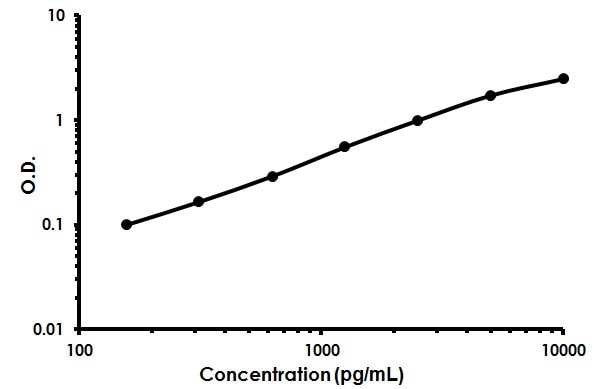Human COMP ELISA Kit (ab213764)
Key features and details
- Sensitivity: 10 pg/ml
- Range: 156 pg/ml - 10000 pg/ml
- Sample type: Cell culture supernatant, Cell Lysate, EDTA Plasma, Hep Plasma, Serum
- Detection method: Colorimetric
- Assay type: Sandwich (quantitative)
- Reacts with: Human
Properties
-
Storage instructions
Store at -20°C. Please refer to protocols. -
Components Identifier 1 x 96 tests ABC Diluent Buffer Blue Cap 1 x 12ml Adhesive Plate Seal 4 units Antibody Diluent Buffer Green Cap 1 x 12ml Anti-Human COMP coated Microplate (12 x 8 wells) 1 unit Avidin-Biotin-Peroxidase Complex (ABC) 1 x 100µl Biotinylated anti- Human COMP antibody 1 x 130µl Lyophilized recombinant Human COMP standard 2 vials Sample Diluent Buffer Green Cap 1 x 30ml TMB Color Developing Agent Black Cap 1 x 10ml TMB Stop Solution Yellow Cap 1 x 10ml -
Research areas
-
Function
May play a role in the structural integrity of cartilage via its interaction with other extracellular matrix proteins such as the collagens and fibronectin. Can mediate the interaction of chondrocytes with the cartilage extracellular matrix through interaction with cell surface integrin receptors. Could play a role in the pathogenesis of osteoarthritis. Potent suppressor of apoptosis in both primary chondrocytes and transformed cells. Suppresses apoptosis by blocking the activation of caspase-3 and by inducing the IAP family of survival proteins (BIRC3, BIRC2, BIRC5 and XIAP). Essential for maintaining a vascular smooth muscle cells (VSMCs) contractile/differentiated phenotype under physiological and pathological stimuli. Maintains this phenotype of VSMCs by interacting with ITGA7. -
Tissue specificity
Abundantly expressed in the chondrocyte extracellular matrix, and is also found in bone, tendon, ligament and synovium and blood vessels. Increased amounts are produced during late stages of osteoarthritis in the area adjacent to the main defect. -
Involvement in disease
Defects in COMP are the cause of multiple epiphyseal dysplasia type 1 (EDM1) [MIM:132400]. EDM is a generalized skeletal dysplasia associated with significant morbidity. Joint pain, joint deformity, waddling gait, and short stature are the main clinical signs and symptoms. EDM is broadly categorized into the more severe Fairbank and the milder Ribbing types.
Defects in COMP are the cause of pseudoachondroplasia (PSACH) [MIM:177170]. PSAC is a dominantly inherited chondrodysplasia characterized by short stature and early-onset osteoarthrosis. PSACH is more severe than EDM1 and is recognized in early childhood. -
Sequence similarities
Belongs to the thrombospondin family.
Contains 4 EGF-like domains.
Contains 1 TSP C-terminal (TSPC) domain.
Contains 8 TSP type-3 repeats. -
Developmental stage
Present during the earliest stages of limb maturation and is later found in regions where the joints develop. -
Domain
The cell attachment motif mediates the attachment to chondrocytes. It mediates the induction of both the IAP family of survival proteins and the antiapoptotic response.
The TSP C-terminal domain mediates interaction with FN1 and ACAN. -
Cellular localization
Secreted > extracellular space > extracellular matrix. - Information by UniProt
-
Alternative names
- Cartilage oligomeric matrix protein
- cartilage oligomeric matrix protein (pseudoachondroplasia, epiphyseal dysplasia 1, multiple)
- Cartilage oligomeric matrix protein precursor
see all -
Database links
- Entrez Gene: 1311 Human
- Omim: 600310 Human
- SwissProt: P49747 Human
- Unigene: 1584 Human

